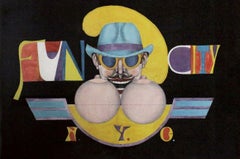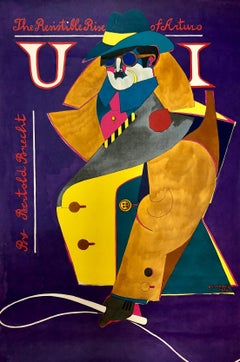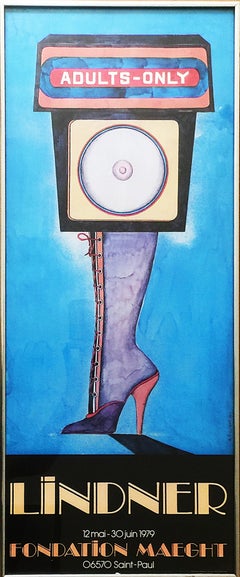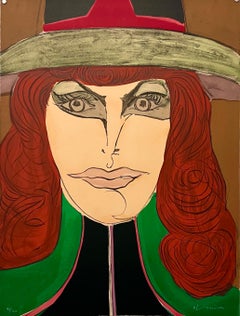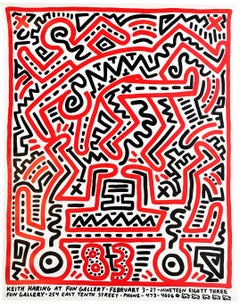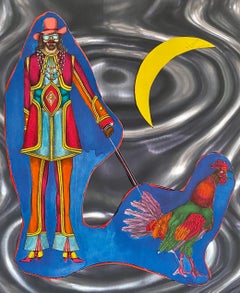Richard Lindner Abstract Prints
American, 1901-1978
Richard Lindner (1901 – 1978) was a German-American painter. Lindner's mother was owner of a custom-fitting corset business and Richard Lindner grew up and studied at the Kunstgewerbeschule (Arts and Crafts School since 1940 Academy of Fine Arts). From 1924 to 1927 he lived in Munich and studied there from 1925 at the Kunstakademie. In 1927 Lindner moved to Berlin and stayed there until 1928, when he returned to Munich to become art director of a publishing firm. He remained in Munich until 1933, when he was forced to flee to Paris. Once in Paris, Lindner became politically engaged, sought contact with French artists and earned his living as a commercial artist. He was interned when World War II broke out in 1939 and later served in the French Army. In 1941, Lindner moved to the United States and worked in New York City as an illustrator of books and magazines. There he made contact with New York artists and German emigrants such as Albert Einstein, Marlene Dietrich, and Saul Steinberg. In 1948, Lindner became an American citizen. Lindner taught at a number of institutions including the Pratt Institute, Brooklyn, Hochschule fur bildende Kunste in Hamburg and Yale University School of Art and Architecture. His paintings often used the sexual symbolism of advertising and investigated definitions of gender roles in the media.(Biography provided by ArtWise)
to
7
1
1
6
2
4
2
2
Overall Height
to
Overall Width
to
6
1
1
2
2
1
1
1
1
1
1
8
3
4
36
542
433
206
180
8
2
Artist: Richard Lindner
Original "Spoleto 1974, Lulu Opera' vintage poster
By Richard Lindner
Located in Spokane, WA
Original linen-backed 1974 Spoleto poster. Roman Polanski directed Alban Berg's opera LuLu at the Spoleto Festival, which was conducted by Christopher K...
Category
1970s Abstract Richard Lindner Abstract Prints
Materials
Lithograph
Vintage Modern Lithograph Poster 1960s Pop Art Mod Figure
By Richard Lindner
Located in Surfside, FL
Vintage 1960's Lithograph poster for Vancouver Canada art show.
Richard Lindner was born in Hamburg, Germany. In 1905 the family moved to Nuremberg, where Lindners mother was owner o...
Category
1960s Pop Art Richard Lindner Abstract Prints
Materials
Lithograph
Fun City, N.Y.C.
By Richard Lindner
Located in New York, NY
A very good impression of this color lithograph. Signed and numbered 125/175 in pencil, lower margin.
Category
1970s Pop Art Richard Lindner Abstract Prints
Materials
Color, Lithograph
Offset Lithograph Poster Resistible Rise of Arturo, Bertold Brecht 1968 Pop Art
By Richard Lindner
Located in Surfside, FL
Plate signed and dated, offset lithograph.
Richard Lindner was born in Hamburg, Germany. In 1905 the family moved to Nuremberg, where Lindners mother was owner of a custom-fitting co...
Category
1960s Pop Art Richard Lindner Abstract Prints
Materials
Lithograph, Offset
Adults-Only
By Richard Lindner
Located in New York, NY
Richard Lindner
Adults-Only, 1979
Offset lithograph poster
Plate signature with date, right front
Frame Included: held in vintage 1970s metal period frame
This is a rare vintage post...
Category
1970s Pop Art Richard Lindner Abstract Prints
Materials
Lithograph, Offset
1971 Modernist Lithograph Redhead Pop Art Mod Fashionable Woman Richard Lindner
By Richard Lindner
Located in Surfside, FL
RICHARD LINDNER (American. 1901-1978)
Hand Signed limited edition lithograph with blindstamp
Publisher: Shorewood-Bank Street Atelier for the Skowhegan School of Painting and Sculpture
29.25 X 22 inches
Richard Lindner was born in Hamburg, Germany. In 1905 the family moved to Nuremberg, where Lindner's mother was owner of a custom-fitting corset business and Richard Lindner grew up and studied at the Kunstgewerbeschule (Arts and Crafts School since 1940 Academy of Fine Arts). From 1924 to 1927 he lived in Munich and studied there from 1925 at the Kunstakademie. In 1927 he moved to Berlin and stayed there until 1928, when he returned to Munich to become art director of a publishing firm. He remained there until 1933, when he was forced to flee to Paris, where he became politically engaged, sought contact with French artists and earned his living as a commercial artist. He was interned when the war broke out in 1939 and later served in the French Army. In 1941 he went to the United States and worked in New York City as an illustrator of books and magazines (Vogue, Fortune and Harper's Bazaar). He began painting seriously in 1952, holding his first one-man exhibit in 1954. His style blends a mechanistic cubism with personal images and haunting symbolism. LIndner maintained contact with the emigre community including New York artists and German emigrants (Albert Einstein, Marlene Dietrich, Saul Steinberg). Though he became a United States citizen in 1948, Lindner considered himself a New Yorker, but not a true American. However, over the course of time, his continental circus women became New York City streetwalkers. New York police uniforms replaced European military uniforms as symbols of authority.At a time when Abstract Expressionism was all the rage, Lindner’s painting went against the current and always kept its distance. His pictorial language of vibrant colours and broad planes of colour and his urban themes make him a forerunner of American Pop Art. At the same time, he owes the critical tone of his paintings to the influence of European art movements such as Neue Sachlichkeit and Dada. His first exhibition did not take place until 1954, by which time he was over fifty, and, interestingly, it was held at the Betty Parsons Gallery in New York, a venue associated with the American Expressionists. From 1952 he taught at the Pratt Institute, Brooklyn, from 1967 at Yale University School of Art and Architecture, New Haven. In 1957 Lindner got the William and Norma Copley Foundation-Award. In 1965 he became Guest Professor at the Akademie für Bildende Künste, Hamburg. His Ice (1966, Whitney Museum of American Art) established a connection between the metaphysical tradition and pop art. He did work on Rowlux which was used by a number of pop artists (most notably Roy Lichtenstein)The painting shows harsh, flat geometric shapes framing an erotic but mechanical robot-woman. His paintings used the sexual symbolism of advertising and investigated definitions of gender roles in the media. While influencing Pop Art (Andy Warhol, Tom Wesselmann and Claes Oldenburg amongst others) his highly colourful, hard-edge style seems to have brought him close to Pop Art, which he rejected. Nevertheless, he is immortalised on the cover of the Beatles record "Sgt. Pepper’s Lonely Hearts Club Band" (1967) as a patron of the pop culture. He also did a tapestry banner with the Betsy Ross Flag...
Category
1970s Pop Art Richard Lindner Abstract Prints
Materials
Lithograph
Vintage Modern Lithograph Poster 1960s Pop Art Mod Figure Pencil Signed
By Richard Lindner
Located in Surfside, FL
Richard Lindner was born in Hamburg, Germany. In 1905 the family moved to Nuremberg, where Lindners mother was owner of a custom-fitting corset business and Richard Lindner grew up and studied at the Kunstgewerbeschule (Arts and Crafts School since 1940 Academy of Fine Arts). From 1924 to 1927 he lived in Munich and studied there from 1925 at the Kunstakademie. In 1927 he moved to Berlin and stayed there until 1928, when he returned to Munich to become art director of a publishing firm. He remained there until 1933, when he was forced to flee to Paris, where he became politically engaged, sought contact with French artists and earned his living as a commercial artist. He was interned when the war broke out in 1939 and later served in the French Army. In 1941 he went to the United States and worked in New York City as an illustrator of books and magazines (Vogue, Fortune and Harper's Bazaar). He began painting seriously in 1952, holding his first one-man exhibit in 1954. His style blends a mechanistic cubism with personal images and haunting symbolism. LIndner maintained contact with the emigre community including New York artists and German emigrants (Albert Einstein, Marlene Dietrich, Saul Steinberg). Though he became a United States citizen in 1948, Lindner considered himself a New Yorker, but not a true American. However, over the course of time, his continental circus women became New York City streetwalkers. New York police uniforms replaced European military uniforms as symbols of authority.At a time when Abstract Expressionism was all the rage, Lindner’s painting went against the current and always kept its distance. His pictorial language of vibrant colours and broad planes of colour and his urban themes make him a forerunner of American Pop Art. At the same time, he owes the critical tone of his paintings to the influence of European art movements such as Neue Sachlichkeit and Dada. His first exhibition did not take place until 1954, by which time he was over fifty, and, interestingly, it was held at the Betty Parsons Gallery in New York, a venue associated with the American Expressionists. From 1952 he taught at the Pratt Institute, Brooklyn, from 1967 at Yale University School of Art and Architecture, New Haven. In 1957 Lindner got the William and Norma Copley Foundation-Award. In 1965 he became Guest Professor at the Akademie für Bildende Künste, Hamburg. His Ice (1966, Whitney Museum of American Art) established a connection between the metaphysical tradition and pop art. The painting shows harsh, flat geometric shapes framing an erotic but mechanical robot-woman.His paintings used the sexual symbolism of advertising and investigated definitions of gender roles in the media. While influencing Pop Art (Tom Wesselman and Claes Oldenburg amongst others) his highly colourful, hard-edge style seems to have brought him close to Pop Art, which he rejected. Nevertheless, he is immortalised on the cover of the Beatles record...
Category
1960s Pop Art Richard Lindner Abstract Prints
Materials
Lithograph
1970's New York original lithograph by Richard Lindner
By Richard Lindner
Located in Petworth, West Sussex
A funky urban image from 1971 depicting some of the nuances of New York seedy underbelly. This original lithograph is number 73 of and edition of 75 from the 1971 'Fun City' suite. Originally there were 12 different artworks in this series by Richard Lindner of which this is the title piece.
Signed in pencil 'R Lindner...
Category
Late 20th Century Modern Richard Lindner Abstract Prints
Materials
Lithograph
Related Items
Keith Haring Fun Gallery exhibition poster 1983 (vintage Keith Haring)
By Keith Haring
Located in NEW YORK, NY
Keith Haring Fun Gallery 1983:
Original 1983 Keith Haring illustrated exhibition poster published on the occasion of Haring's historic 1983 show at the Fun Gallery in the East Village. A classic array of early Haring imagery that reveals red and black interlocking figures. A rare example in very good overall vintage condition.
Offset lithograph in colors on smooth wove paper.
23 x 29 inches.
Only some minor signs of handling; in otherwise very good overall vintage condition with strong colors; one of the better examples we've come across. Stored away from light; never mounted or framed.
Unsigned from an edition of unknown; scarce.
Catalog Raisonne:
Keith Haring: Posters (Prestel Publishing).
References:
Included in the collection of the Cooper Hewitt, Smithsonian Design Museum.
About the Fun Gallery:
Historic, short-lived, East Village gallery known for giving Keith Haring, Basquiat & Kenny Scharf some of their first solo shows.
“FUN Gallery was a place where neighborhood kids, downtown artists, b-boys, rock, film, and rap stars mixed with museum directors art historians and uptown collectors at wild openings featuring artists like Futura, Fab 5...
Category
1980s Pop Art Richard Lindner Abstract Prints
Materials
Lithograph, Offset
1970s Alexander Calder poster (Calder Braniff Airlines 1976)
By Alexander Calder
Located in NEW YORK, NY
Alexander Calder Braniff Airlines poster 1976:
Medium: Offset lithograph.
Dimensions: 23 x 33 inches.
An original 1st printing in very good ...
Category
1970s Pop Art Richard Lindner Abstract Prints
Materials
Lithograph, Offset
Francis Bacon, signed 182/250 offset lithograph, study of the human body, 1980
By Francis Bacon
Located in Petworth, West Sussex
Rare, striking signed Francis Bacon lithograph from 1980, number 182 / 250.
Details of the work are as follows:
Francis Bacon (irish, 1909 ...
Category
20th Century Abstract Richard Lindner Abstract Prints
Materials
Lithograph
H 43.38 in W 32.63 in D 1 in
Milton Glaser The Lovin' Spoonful poster (Milton Glaser posters)
By Milton Glaser
Located in NEW YORK, NY
1970s Milton Glaser Poster Art:
Milton Glaser The Lovin' Spoonful: Vintage original Milton Glaser poster c.1972. Designed by Milton Glaser on the occasion of: "The Lovin' Spoonful a...
Category
1960s Pop Art Richard Lindner Abstract Prints
Materials
Lithograph, Offset
Milton Glaser Mozart 1983 poster (Milton Glaser posters)
By Milton Glaser
Located in NEW YORK, NY
Milton Glaser Mozart poster 1983:
Vintage original 1983 Milton Glaser poster designed by Glaser on the occasion of Lincoln Center, Mostly Mozart Festival.
A timeless, highly decorative Milton Glaser poster capturing Mozart in unique personalized movement, rendered with brilliant pastel colors.
Offset lithograph poster in colors.
36 x 24 inches.
Very good overall vintage condition with the exception of perhaps some minor signs of handling.
Printed signature from an edition of unknown.
Literature:
Milton Glaser Posters, Glaser.
Legendary graphic designer, illustrator, and art director Milton Glaser created some of the most recognizable iconography in America today —including the iconic I ♥ N Y logo —and countless posters and ad campaigns. Glaser changed the face of commercial art in the 1960s and ’70s, breaking with the conventions of modernism and drawing inspiration from a wide variety of art-historical and pop-cultural sources, from Art Nouveau to comic illustration and Chinese drawings. As a co-founder of New York magazine, Glaser designed...
Category
1980s Pop Art Richard Lindner Abstract Prints
Materials
Lithograph, Offset
Keith Haring Paradise Garage Exhibit Poster 'Keith Haring Jeffrey Deitch'
By Keith Haring
Located in NEW YORK, NY
Rare vintage Keith Haring exhibition poster published on the occasion of:
‘Paradise Garage: Keith Haring and Music,
December 14, 2000-February 10, 2001, Deitch Projects, 18 Wooster ...
Category
1980s Pop Art Richard Lindner Abstract Prints
Materials
Paper, Lithograph, Offset
Original historic Champions poster Scharf Cutrone (Hand signed by Keith Haring)
By Keith Haring
Located in New York, NY
Keith Haring
Champions 1984 (Hand signed by Keith Haring), 1988
Offset lithograph (Hand signed and dated 1988 by Keith Haring with his logo)
Boldly signed and dated '88 by Keith Haring with his distinctive logo in black marker under his printed signature.
Published by The Contemporary Art Center of Cleveland
Original vintage metal frame included
This is the ORIGINAL (not a later reprint) 1984 invitation to the famous 1984 Champions show at the The Contemporary Art Center of Cleveland, Ohio. The artist who participated in this show and are named on the print are:
Keith Haring, James Brown, Ronnie Cutrone, Brett De Palma, Future 2000, Kenny Scharf, and Dan Friedman...
Category
1980s Pop Art Richard Lindner Abstract Prints
Materials
Offset, Felt Pen, Lithograph
H 30 in W 20 in D 0.5 in
Absolut Ruscha
By Ed Ruscha
Located in New York, NY
Ed Ruscha
Absolut Ruscha, 1988
Offset Lithograph in colors on wove paper
Hand signed and dated by Ed Ruscha in pencil on lower right front
Limited Edition of 200 (unnumbered)
45.25 x...
Category
1980s Pop Art Richard Lindner Abstract Prints
Materials
Lithograph, Pencil
Alexander Calder Roses lithograph (1960s Calder)
By Alexander Calder
Located in NEW YORK, NY
Alexander Calder Lithograph c. 1966:
Lithograph in colors; 11 x 15 inches.
Very good overall vintage condition.
Unsigned from an edition of unknown.
From: Derrière le miroir Publish...
Category
Mid-20th Century Pop Art Richard Lindner Abstract Prints
Materials
Lithograph
1960s Antoni Tàpies Derrière le miroir cover (Tàpies prints)
By Antoni Tàpies
Located in NEW YORK, NY
1960s Antoni Tàpies Lithographic cover to Derrière le miroir:
Lithographic publication cover; circa 1968.
11 x 15 inches.
Good overall vintage condition as pictured.
Unsigned from a...
Category
1960s Abstract Richard Lindner Abstract Prints
Materials
Lithograph
Takashi Murakami 'Superflat' exhibition poster (vintage Takashi Murakami)
By Takashi Murakami
Located in NEW YORK, NY
Takashi Murakami Superflat Exhibition Poster 1999:
Rare 1990s exhibit poster designed by Murakami and published by Marianne Boesky Gallery New York...
Category
21st Century and Contemporary Pop Art Richard Lindner Abstract Prints
Materials
Lithograph, Offset
H 22 in W 17 in D 0.01 in
Milton Glaser Bach poster (Milton Glaser posters)
By Milton Glaser
Located in NEW YORK, NY
Milton Glaser:
Vintage original 1980s Milton Glaser poster designed by Glaser on the occasion of the release of Bach's complete keyboard works on digital recording. A timeless, highly decorative vintage Milton Glaser poster that is sure to stand out in any setting.
Offset lithograph poster in colors.
36 x 24 inches.
Very good overall vintage condition with the exception of perhaps some minor signs of handling.
Unsigned from an edition of unknown.
Literature:
Milton Glaser Posters, Glaser.
Legendary graphic designer, illustrator, and art director Milton Glaser created some of the most recognizable iconography in America today —including the iconic I ♥ N Y logo —and countless posters and ad campaigns. Glaser changed the face of commercial art in the 1960s and ’70s, breaking with the conventions of modernism and drawing inspiration from a wide variety of art-historical and pop-cultural sources, from Art Nouveau to comic illustration and Chinese drawings. As a co-founder of New York magazine, Glaser designed...
Category
1960s Pop Art Richard Lindner Abstract Prints
Materials
Lithograph, Offset
Previously Available Items
Modernist Lithograph Lovers Kiss Pop Art Mod Figure Richard Lindner Graphic Art
By Richard Lindner
Located in Surfside, FL
RICHARD LINDNER (American. 1901-1978)
32/49 Hand Signed ithograph
Framed MEASURES 43" X 57" IMAGE MEASURES 26" X 20"
Richard Lindner was born in Hamburg, Germany. In 1905 the family moved to Nuremberg, where Lindners mother was owner of a custom-fitting corset business and Richard Lindner grew up and studied at the Kunstgewerbeschule (Arts and Crafts School since 1940 Academy of Fine Arts). From 1924 to 1927 he lived in Munich and studied there from 1925 at the Kunstakademie. In 1927 he moved to Berlin and stayed there until 1928, when he returned to Munich to become art director of a publishing firm. He remained there until 1933, when he was forced to flee to Paris, where he became politically engaged, sought contact with French artists and earned his living as a commercial artist. He was interned when the war broke out in 1939 and later served in the French Army. In 1941 he went to the United States and worked in New York City as an illustrator of books and magazines (Vogue, Fortune and Harper's Bazaar). He began painting seriously in 1952, holding his first one-man exhibit in 1954. His style blends a mechanistic cubism with personal images and haunting symbolism. LIndner maintained contact with the emigre community including New York artists and German emigrants (Albert Einstein, Marlene Dietrich, Saul Steinberg). Though he became a United States citizen in 1948, Lindner considered himself a New Yorker, but not a true American. However, over the course of time, his continental circus women became New York City streetwalkers. New York police uniforms replaced European military uniforms as symbols of authority.At a time when Abstract Expressionism was all the rage, Lindner’s painting went against the current and always kept its distance. His pictorial language of vibrant colours and broad planes of colour and his urban themes make him a forerunner of American Pop Art. At the same time, he owes the critical tone of his paintings to the influence of European art movements such as Neue Sachlichkeit and Dada. His first exhibition did not take place until 1954, by which time he was over fifty, and, interestingly, it was held at the Betty Parsons Gallery in New York, a venue associated with the American Expressionists. From 1952 he taught at the Pratt Institute, Brooklyn, from 1967 at Yale University School of Art and Architecture, New Haven. In 1957 Lindner got the William and Norma Copley Foundation-Award. In 1965 he became Guest Professor at the Akademie für Bildende Künste, Hamburg. His Ice (1966, Whitney Museum of American Art) established a connection between the metaphysical tradition and pop art. He did work on Rowlux which was used by a number of pop artists (most notably Roy Lichtenstein)The painting shows harsh, flat geometric shapes framing an erotic but mechanical robot-woman. His paintings used the sexual symbolism of advertising and investigated definitions of gender roles in the media. While influencing Pop Art (Andy Warhol, Tom Wesselmann and Claes Oldenburg amongst others) his highly colourful, hard-edge style seems to have brought him close to Pop Art, which he rejected. Nevertheless, he is immortalised on the cover of the Beatles record "Sgt. Pepper’s Lonely Hearts Club Band" (1967) as a patron of the pop culture. He also did a tapestry banner with the Betsy Ross Flag...
Category
1970s Pop Art Richard Lindner Abstract Prints
Materials
Lithograph
Modernist Lithograph and Collage on Rowlux Pop Art Mod Figure Richard Lindner
By Richard Lindner
Located in Surfside, FL
St. Marks, 1971
Lithograph and Collage on Gray Rowlux
Rowlux was used by a number of pop artists (most notably Roy Lichtenstein)
Richard Lindner was born in Hamburg, Germany. In 1905 the family moved to Nuremberg, where Lindners mother was owner of a custom-fitting corset business and Richard Lindner grew up and studied at the Kunstgewerbeschule (Arts and Crafts School since 1940 Academy of Fine Arts). From 1924 to 1927 he lived in Munich and studied there from 1925 at the Kunstakademie. In 1927 he moved to Berlin and stayed there until 1928, when he returned to Munich to become art director of a publishing firm. He remained there until 1933, when he was forced to flee to Paris, where he became politically engaged, sought contact with French artists and earned his living as a commercial artist. He was interned when the war broke out in 1939 and later served in the French Army. In 1941 he went to the United States and worked in New York City as an illustrator of books and magazines (Vogue, Fortune and Harper's Bazaar). He began painting seriously in 1952, holding his first one-man exhibit in 1954. His style blends a mechanistic cubism with personal images and haunting symbolism. LIndner maintained contact with the emigre community including New York artists and German emigrants (Albert Einstein, Marlene Dietrich, Saul Steinberg). Though he became a United States citizen in 1948, Lindner considered himself a New Yorker, but not a true American. However, over the course of time, his continental circus women became New York City streetwalkers. New York police uniforms replaced European military uniforms as symbols of authority.At a time when Abstract Expressionism was all the rage, Lindner’s painting went against the current and always kept its distance. His pictorial language of vibrant colours and broad planes of colour and his urban themes make him a forerunner of American Pop Art. At the same time, he owes the critical tone of his paintings to the influence of European art movements such as Neue Sachlichkeit and Dada. His first exhibition did not take place until 1954, by which time he was over fifty, and, interestingly, it was held at the Betty Parsons Gallery in New York, a venue associated with the American Expressionists. From 1952 he taught at the Pratt Institute, Brooklyn, from 1967 at Yale University School of Art and Architecture, New Haven. In 1957 Lindner got the William and Norma Copley Foundation-Award. In 1965 he became Guest Professor at the Akademie für Bildende Künste, Hamburg. His Ice (1966, Whitney Museum of American Art) established a connection between the metaphysical tradition and pop art. The painting shows harsh, flat geometric shapes framing an erotic but mechanical robot-woman. His paintings used the sexual symbolism of advertising and investigated definitions of gender roles in the media. While influencing Pop Art (Tom Wesselmann and Claes Oldenburg amongst others) his highly colourful, hard-edge style seems to have brought him close to Pop Art, which he rejected. Nevertheless, he is immortalised on the cover of the Beatles record...
Category
1970s Pop Art Richard Lindner Abstract Prints
Materials
Plastic, Lithograph
Vintage Modern Lithograph Poster 1960s Pop Art Mod Figure
By Richard Lindner
Located in Surfside, FL
Vintage 1960's Lithograph poster for Vancouver Canada art show.
Richard Lindner was born in Hamburg, Germany. In 1905 the family moved to Nuremberg, where Lindners mother was owner of a custom-fitting corset business and Richard Lindner grew up and studied at the Kunstgewerbeschule (Arts and Crafts School since 1940 Academy of Fine Arts). From 1924 to 1927 he lived in Munich and studied there from 1925 at the Kunstakademie. In 1927 he moved to Berlin and stayed there until 1928, when he returned to Munich to become art director of a publishing firm. He remained there until 1933, when he was forced to flee to Paris, where he became politically engaged, sought contact with French artists and earned his living as a commercial artist. He was interned when the war broke out in 1939 and later served in the French Army. In 1941 he went to the United States and worked in New York City as an illustrator of books and magazines (Vogue, Fortune and Harper's Bazaar). He began painting seriously in 1952, holding his first one-man exhibit in 1954. His style blends a mechanistic cubism with personal images and haunting symbolism. LIndner maintained contact with the emigre community including New York artists and German emigrants (Albert Einstein, Marlene Dietrich, Saul Steinberg). Though he became a United States citizen in 1948, Lindner considered himself a New Yorker, but not a true American. However, over the course of time, his continental circus women became New York City streetwalkers. New York police uniforms replaced European military uniforms as symbols of authority.At a time when Abstract Expressionism was all the rage, Lindner’s painting went against the current and always kept its distance. His pictorial language of vibrant colours and broad planes of colour and his urban themes make him a forerunner of American Pop Art. At the same time, he owes the critical tone of his paintings to the influence of European art movements such as Neue Sachlichkeit and Dada. His first exhibition did not take place until 1954, by which time he was over fifty, and, interestingly, it was held at the Betty Parsons Gallery in New York, a venue associated with the American Expressionists. From 1952 he taught at the Pratt Institute, Brooklyn, from 1967 at Yale University School of Art and Architecture, New Haven. In 1957 Lindner got the William and Norma Copley Foundation-Award. In 1965 he became Guest Professor at the Akademie für Bildende Künste, Hamburg. His Ice (1966, Whitney Museum of American Art) established a connection between the metaphysical tradition and pop art. The painting shows harsh, flat geometric shapes framing an erotic but mechanical robot-woman.His paintings used the sexual symbolism of advertising and investigated definitions of gender roles in the media. While influencing Pop Art (Tom Wesselman and Claes Oldenburg amongst others) his highly colourful, hard-edge style seems to have brought him close to Pop Art, which he rejected. Nevertheless, he is immortalised on the cover of the Beatles record...
Category
1960s Pop Art Richard Lindner Abstract Prints
Materials
Lithograph
Offset Lithograph Poster Resistible Rise of Arturo, Bertold Brecht 1968 Pop Art
By Richard Lindner
Located in Surfside, FL
Plate signed and dated, offset lithograph.
Richard Lindner was born in Hamburg, Germany. In 1905 the family moved to Nuremberg, where Lindners mother was owner of a custom-fitting corset business and Richard Lindner grew up and studied at the Kunstgewerbeschule (Arts and Crafts School since 1940 Academy of Fine Arts). From 1924 to 1927 he lived in Munich and studied there from 1925 at the Kunstakademie. In 1927 he moved to Berlin and stayed there until 1928, when he returned to Munich to become art director of a publishing firm. He remained there until 1933, when he was forced to flee to Paris, where he became politically engaged, sought contact with French artists and earned his living as a commercial artist. He was interned when the war broke out in 1939 and later served in the French Army. In 1941 he went to the United States and worked in New York City as an illustrator of books and magazines (Vogue, Fortune and Harper's Bazaar). He began painting seriously in 1952, holding his first one-man exhibit in 1954. His style blends a mechanistic cubism with personal images and haunting symbolism. LIndner maintained contact with the emigre community including New York artists and German emigrants (Albert Einstein, Marlene Dietrich, Saul Steinberg). Though he became a United States citizen in 1948, Lindner considered himself a New Yorker, but not a true American. However, over the course of time, his continental circus women became New York City streetwalkers. New York police uniforms replaced European military uniforms as symbols of authority.At a time when Abstract Expressionism was all the rage, Lindner’s painting went against the current and always kept its distance. His pictorial language of vibrant colours and broad planes of colour and his urban themes make him a forerunner of American Pop Art. At the same time, he owes the critical tone of his paintings to the influence of European art movements such as Neue Sachlichkeit and Dada. His first exhibition did not take place until 1954, by which time he was over fifty, and, interestingly, it was held at the Betty Parsons Gallery in New York, a venue associated with the American Expressionists. From 1952 he taught at the Pratt Institute, Brooklyn, from 1967 at Yale University School of Art and Architecture, New Haven. In 1957 Lindner got the William and Norma Copley Foundation-Award. In 1965 he became Guest Professor at the Akademie für Bildende Künste, Hamburg. His Ice (1966, Whitney Museum of American Art) established a connection between the metaphysical tradition and pop art. The painting shows harsh, flat geometric shapes framing an erotic but mechanical robot-woman.His paintings used the sexual symbolism of advertising and investigated definitions of gender roles in the media. While influencing Pop Art (Tom Wesselman and Claes Oldenburg amongst others) his highly colourful, hard-edge style seems to have brought him close to Pop Art, which he rejected. Nevertheless, he is immortalised on the cover of the Beatles record...
Category
1960s Pop Art Richard Lindner Abstract Prints
Materials
Offset, Lithograph
Vintage Modern Lithograph Poster 1960s Pop Art Mod Figure Pencil Signed
By Richard Lindner
Located in Surfside, FL
Richard Lindner was born in Hamburg, Germany. In 1905 the family moved to Nuremberg, where Lindners mother was owner of a custom-fitting corset business and Richard Lindner grew up and studied at the Kunstgewerbeschule (Arts and Crafts School since 1940 Academy of Fine Arts). From 1924 to 1927 he lived in Munich and studied there from 1925 at the Kunstakademie. In 1927 he moved to Berlin and stayed there until 1928, when he returned to Munich to become art director of a publishing firm. He remained there until 1933, when he was forced to flee to Paris, where he became politically engaged, sought contact with French artists and earned his living as a commercial artist. He was interned when the war broke out in 1939 and later served in the French Army. In 1941 he went to the United States and worked in New York City as an illustrator of books and magazines (Vogue, Fortune and Harper's Bazaar). He began painting seriously in 1952, holding his first one-man exhibit in 1954. His style blends a mechanistic cubism with personal images and haunting symbolism. LIndner maintained contact with the emigre community including New York artists and German emigrants (Albert Einstein, Marlene Dietrich, Saul Steinberg). Though he became a United States citizen in 1948, Lindner considered himself a New Yorker, but not a true American. However, over the course of time, his continental circus women became New York City streetwalkers. New York police uniforms replaced European military uniforms as symbols of authority.At a time when Abstract Expressionism was all the rage, Lindner’s painting went against the current and always kept its distance. His pictorial language of vibrant colours and broad planes of colour and his urban themes make him a forerunner of American Pop Art. At the same time, he owes the critical tone of his paintings to the influence of European art movements such as Neue Sachlichkeit and Dada. His first exhibition did not take place until 1954, by which time he was over fifty, and, interestingly, it was held at the Betty Parsons Gallery in New York, a venue associated with the American Expressionists. From 1952 he taught at the Pratt Institute, Brooklyn, from 1967 at Yale University School of Art and Architecture, New Haven. In 1957 Lindner got the William and Norma Copley Foundation-Award. In 1965 he became Guest Professor at the Akademie für Bildende Künste, Hamburg. His Ice (1966, Whitney Museum of American Art) established a connection between the metaphysical tradition and pop art. The painting shows harsh, flat geometric shapes framing an erotic but mechanical robot-woman.His paintings used the sexual symbolism of advertising and investigated definitions of gender roles in the media. While influencing Pop Art (Tom Wesselman and Claes Oldenburg amongst others) his highly colourful, hard-edge style seems to have brought him close to Pop Art, which he rejected. Nevertheless, he is immortalised on the cover of the Beatles record...
Category
1960s Pop Art Richard Lindner Abstract Prints
Materials
Lithograph
Richard Lindner abstract prints for sale on 1stDibs.
Find a wide variety of authentic Richard Lindner abstract prints available for sale on 1stDibs. You can also browse by medium to find art by Richard Lindner in lithograph, offset print and more. Much of the original work by this artist or collective was created during the 20th century and is mostly associated with the Pop Art style. Not every interior allows for large Richard Lindner abstract prints, so small editions measuring 17 inches across are available. Customers who are interested in this artist might also find the work of CLAYTON POND, Jack Brusca, and Red Grooms. Richard Lindner abstract prints prices can differ depending upon medium, time period and other attributes. On 1stDibs, the price for these items starts at $500 and tops out at $2,420, while the average work can sell for $1,200.


